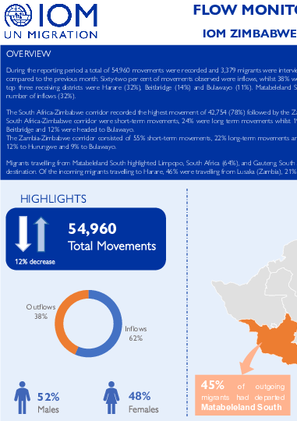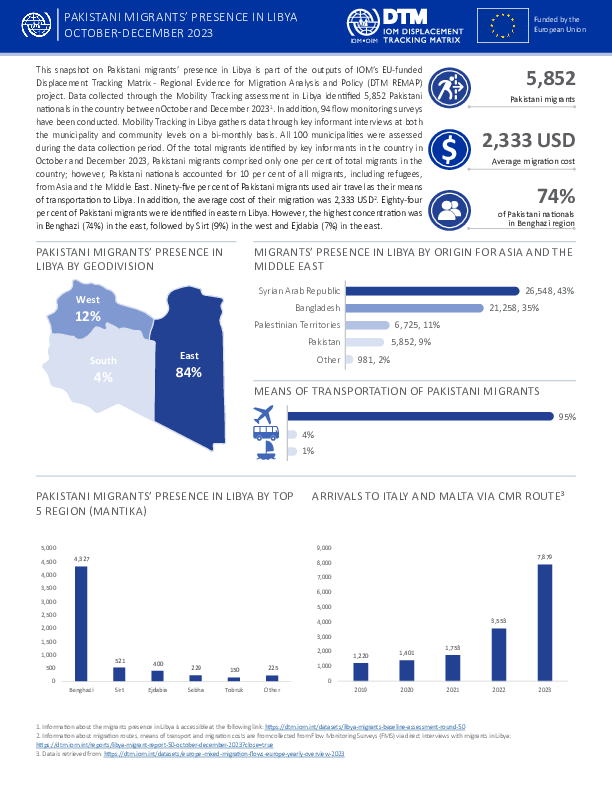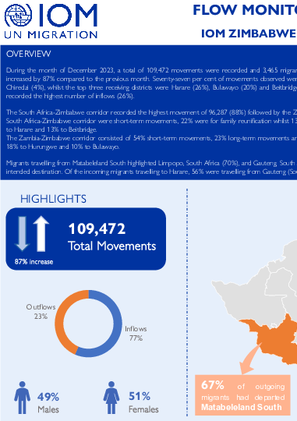-
Countries
-
Data and Analysis
-
Special Focus
-
Crisis Responses

Contact
DTM Zimbabwe, DTMzimbabwe@iom.int, DTMsupport@iom.int
Language
English
Location
Zimbabwe
Period Covered
Mar 01 2024
Mar 29 2024
Activity
- Flow Monitoring
During the reporting period a total of 58,276 movements were recorded and 2,103 migrants were interviewed across 20 Flow Monitoring Points (FMPs) in Zimbabwe. The total movements recorded increased by 6% compared to the previous month. Sixty-seven per cent of movements observed were inflows, whilst 33% were outflows. The top three sending districts were Beitbridge (55%), Harare (11%) and Chiredzi (8%), whilst the top three receiving districts were Harare (28%), Beitbridge (15%) and Bulawayo (10%). Matabeleland South province recorded the highest number of outflows (57%) whilst Harare province recorded the highest number of inflows (28%). The South Africa-Zimbabwe corridor recorded the highest movement of 52,976 (91%) followed by the Zambia-Zimbabwe corridor which recorded 5,300 (9%) movements. Fifty-six per cent of movements along the South Africa-Zimbabwe corridor were short-term movements, 21% were family reunification movements whilst 19% were long-term economic movements. Of the migrants travelling from South Africa, 19% travelled to Harare, 19% to Beitbridge and 10% were headed to Bulawayo. The Zambia-Zimbabwe corridor consisted of 52% short-term movements, 24% long-term economic movements and 23% family reunification movements. Of the migrants travelling from Zambia, 65% were travelling to Harare, 17% to Hurungwe and 8% to Bulawayo. Migrants travelling from Matabeleland South highlighted Limpopo (72%) and Gauteng, South Africa (26%) as their intended destination.. Of the incoming migrants travelling to Harare, 73% were travelling from Gauteng whilst 27% were travelling from Gauteng province in South Africa.

Contact
DTM Zimbabwe, DTMzimbabwe@iom.int, DTMsupport@iom.int
Language
English
Location
Zimbabwe
Period Covered
Feb 01 2024
Feb 29 2024
Activity
- Flow Monitoring
During the reporting period a total of 54,960 movements were recorded and 3,379 migrants were interviewed across 38 Flow Monitoring Points (FMPs) in Zimbabwe. The total movements recorded decreased by 12% compared to the previous month. Sixty-two per cent of movements observed were inflows, whilst 38% were outflows. The top three sending districts were Beitbridge (40%), Harare (14%) and Chiredzi (9%), whilst the top three receiving districts were Harare (32%), Beitbridge (14%) and Bulawayo (11%). Matabeleland South province recorded the highest number of outflows (45%) whilst Harare province recorded the highest number of inflows (32%). The South Africa-Zimbabwe corridor recorded the highest movement of 42,754 (78%) followed by the Zambia-Zimbabwe corridor which recorded 7,454 (14%) movements. Fifty-two per cent of movements along the South Africa-Zimbabwe corridor were short-term movements, 24% were long term movements whilst 19% were for family reunification. Of the migrants travelling from South Africa, 23% travelled to Harare, 20% to Beitbridge and 12% were headed to Bulawayo. The Zambia-Zimbabwe corridor consisted of 55% short-term movements, 22% long-term movements and 22% family reunification movements. Of the migrants travelling from Zambia, 64% were travelling to Harare, 12% to Hurungwe and 9% to Bulawayo. Migrants travelling from Matabeleland South highlighted Limpopo, South Africa (64%), and Gauteng, South Africa (22%) as their intended destination. Those travelling to Botswana indicated Central (4%) as their intended destination. Of the incoming migrants travelling to Harare, 46% were travelling from Lusaka (Zambia), 21% from Gauteng (South Africa), and 10% from Eastern Cape (South Africa).

Contact
DTM Zimbabwe, DTMzimbabwe@iom.int, DTMsupport@iom.int
Language
English
Location
Zimbabwe
Period Covered
Jan 01 2024
Jan 31 2024
Activity
- Flow Monitoring
During the reporting period a total of 62,339 movements were recorded and 3,811 migrants were interviewed across 38 Flow Monitoring Points (FMPs) in Zimbabwe. The total movements recorded decreased by 43% compared to the previous month. Sixty per cent of movements observed were inflows, whilst 40% were outflows. The top three sending districts were Beitbridge (41%), Harare (15%) and Chiredzi (10%), whilst the top three receiving districts were Harare (36%), Beitbridge (13%) and Bulawayo (9%). Matabeleland South province recorded the highest number of outflows (46%) whilst Harare province recorded the highest number of inflows (36%). The South Africa-Zimbabwe corridor recorded the highest movement of 49,574 (80%) followed by the Zambia-Zimbabwe corridor which recorded 7,975 (13%) movements. Forty-nine per cent of movements along the South Africa-Zimbabwe corridor were short-term movements, 28% were long term movements whilst 17% were for family reunification. Of the migrants travelling from South Africa, 30% travelled to Harare, 19% to Beitbridge and 11% were headed to Bulawayo. The Zambia-Zimbabwe corridor consisted of 58% short-term movements, 21% long-term movements and 20% family reunification movements. Of the migrants travelling from Zambia, 64% were travelling to Harare, 14% to Hurungwe and 7% to Gweru. Migrants travelling from Matabeleland South highlighted Limpopo, South Africa (51%), and Gauteng, South Africa (37%) as their intended destination. Those travelling to Botswana indicated Francistown (3%) as their intended destination. Of the incoming migrants travelling to Harare, 33% were travelling from Lusaka (Zambia), 28% from Gauteng (South Africa), and 14% from Eastern Cape (South Africa).
During the month of December 2023, a total of 109,472 movements were recorded and 3,465 migrants were interviewed across 38 Flow Monitoring Points (FMPs) in Zimbabwe. The total movements recorded increased by 87% compared to the previous month. Seventy-seven per cent of movements observed were inflows, whilst 23% were outflows. The top three sending districts were Beitbridge (64%), Harare (12%) and Chiredzi (4%), whilst the top three receiving districts were Harare (26%), Bulawayo (20%) and Beitbridge (11%). Matabeleland South province recorded the highest number of outflows (67%) whilst Harare province recorded the highest number of inflows (26%). The South Africa-Zimbabwe corridor recorded the highest movement of 96,287 (88%) followed by the Zambia-Zimbabwe corridor which recorded 8,588 (8%) movements. Sixty-two per cent of movements along the South Africa-Zimbabwe corridor were short-term movements, 22% were for family reunification whilst 13% were long-term movements. Of the migrants travelling from South Africa, 22% were going to Bulawayo, 22% to Harare and 13% to Beitbridge. The Zambia-Zimbabwe corridor consisted of 54% short-term movements, 23% long-term movements and 21% family reunification movements. Of the migrants travelling from Zambia, 55% were travelling to Harare, 18% to Hurungwe and 10% to Bulawayo. Migrants travelling from Matabeleland South highlighted Limpopo, South Africa (70%), and Gauteng, South Africa (18%) as their intended destination. Those travelling to Botswana indicated Central Province (4%) as their intended destination. Of the incoming migrants travelling to Harare, 56% were travelling from Gauteng (South Africa), 24% from Lusaka (Zambia), and 5% from Western Cape (South Africa).

Contact
DTM Zimbabwe, DTMzimbabwe@iom.int, DTMsupport@iom.int
Language
English
Location
Zimbabwe
Period Covered
Nov 01 2023
Nov 30 2023
Activity
- Flow Monitoring
During the month of November 2023, a total of 58,669 movements were recorded and 3,679 migrants were interviewed across 38 Flow Monitoring Points (FMPs) in Zimbabwe. The total movements recorded increased by 0.2% compared to the previous month. Sixty-eight per cent of movements observed were inflows, whilst 32% were outflows. The top three sending districts were Beitbridge (47%), Harare (16%) and Chiredzi (7%), whilst the top three receiving districts were Harare (30%), Beitbridge (12%) and Bulawayo (10%). Matabeleland South province recorded the highest number of outflows (52%) whilst Harare province recorded the highest number of inflows (31%). The South Africa-Zimbabwe corridor recorded the highest movement of 46,911 (80%) followed by the Zambia-Zimbabwe corridor which recorded 7,272 (12%) movements. Fifty-nine per cent of movements along the South Africa-Zimbabwe corridor were short-term movements, 20% were for family reunification whilst 20% were long-term economic movements. Of the migrants travelling from South Africa, 25% were going to Harare, 15% to Beitbridge and 9% to Bulawayo. The Zambia-Zimbabwe corridor consisted of 53% short-term movements, 24% family reunification movements and 22% long-term movements. Of the migrants travelling from Zambia, 54% were travelling to Harare, 15% to Bulawayo and 13% to Hurungwe. Migrants travelling from Matabeleland South highlighted Limpopo, South Africa (69%), and Gauteng, South Africa (19%) as their intended destination. Those travelling to Botswana indicated Central Province (3%) as their intended destination. Of the incoming migrants travelling to Harare, 35% were travelling from Gauteng (South Africa), 30% from Lusaka (Zambia), and 13% from Eastern Cape (South Africa).

Contact
DTM Peru, IOMDTMPeru@iom.int
Language
Spanish
Location
Peru
Period Covered
Jan 01 2024
Jan 31 2024
Activity
- Flow Monitoring
En el mes de enero de 2024, el contexto en las fronteras de Tumbes, Tacna y Desaguadero estuvo caracterizado por diversos acontecimientos. En Tumbes, la provincia de Zarumilla ha continuado en Estado de Emergencia por noveno mes, con una extensión de 60 días, a fin de controlar el orden interno y mitigar la migración irregular. En Tacna, continúa en evaluación el plan piloto de accesibilidad de transporte colectivo en la ruta Tacna-Arica, para mejorar y garantizar un paso fronterizo ágil y seguro. En Puno, se registró una disminución de los flujos debido al bloqueo de carreteras que conectan con el Estado Plurinacional de Bolivia (en adelante, Bolivia) y Chile, dado la tensión política que vive Bolivia. Estos bloqueos han generado nuevas rutas para las personas en tránsito, una de ellas es por Assis (Brasil) - Madre de Dios (Perú).

Contact
DTM Pakistan, iomisbdtmremapteam@iom.int; DTM Libya, DTMLibya@iom.int
Language
English
Location
Libya
Period Covered
Oct 01 2023
Dec 31 2023
Activity
- Survey
- Flow Monitoring Survey
- Mobility Tracking
- Baseline Assessment
This snapshot on Pakistani migrants’ presence in Libya is part of the outputs of IOM’s EU-funded Displacement Tracking Matrix - Regional Evidence for Migration Analysis and Policy (DTM REMAP) project. Data collected through the Mobility Tracking assessment in Libya identified 5,852 Pakistani nationals in the country between October and December 20231. In addition, 94 flow monitoring surveys have been conducted. Mobility Tracking in Libya gathers data through key informant interviews at both the municipality and community levels on a bi-monthly basis. All 100 municipalities were assessed during the data collection period. Of the total migrants identified by key informants in the country in October and December 2023, Pakistani migrants comprised only one per cent of total migrants in the country; however, Pakistani nationals accounted for 10 per cent of all migrants, including refugees, from Asia and the Middle East. Ninety-five per cent of Pakistani migrants used air travel as their means of transportation to Libya. In addition, the average cost of their migration was 2,333 USD2. Eighty-four per cent of Pakistani migrants were identified in eastern Libya. However, the highest concentration was in Benghazi (74%) in the east, followed by Sirt (9%) in the west and Ejdabia (7%) in the east.
This report provides insights into the profiles, experiences, needs, routes travelled and intentions of migrants transiting through the Western Balkans.
IOM surveyed 1,484 migrants from 1 March to 31 March 2024 in Albania, Bosnia and Herzegovina, Montenegro, North Macedonia, Serbia and Kosovo*.
* References to Kosovo* shall be understood in the context of UN Security Council Resolution 1244 (1999).

Contact
DTM Ukraine, dtmukraine@iom.int
Language
English
Location
Ukraine
Period Covered
Nov 27 2023
Dec 27 2023
Activity
- Other
Since the full-scale invasion of Ukraine in February 2022, the country has confronted profound economic disruptions alongside widespread displacement. With millions seeking safety and stability, the challenges of maintaining livelihoods, securing employment, and accessing social protection are paramount, necessitating focused interventions to mitigate economic hardships.
This report examines the economic ramifications of the war in Ukraine, focusing on changes in income levels, employment trends, and social assistance measures. Drawing on data from the IOM General Population Survey (GPS), this report aims to support evidence-based programming, policy-making, advocacy, and further research on the subject.
Contact
DTMUKRAINE@IOM.INT
Location
Ukraine
Activity
- Mobility Tracking
Period Covered
Mar 01 2024 -Mar 31 2024
IOM's Data and Analytics (D&A) Unit developed the Mobility and Needs Assessment (MaNA), a monthly, multi-sectoral assessment designed to systematically monitor the estimated current presence of key population groups, including de facto Internally Displaced Persons (IDPs), returnees and non-displaced residents, at the hromada level. MaNA also offers a regular baseline for evaluating population needs at a granular level, with a specific focus on hard-to-reach areas. It utilizes sector specific indicators, serving as a compass to steer humanitarian programming and response efforts.
This dataset presents the primary findings from the seventh round of MaNA, conducted in March 2024 across 255 hromadas located in 23 oblasts and Kyiv City. Assessed hromadas were selected based on their relevance to humanitarian programming, pre-war population size, and known displacement trends.
This is a restricted dataset. To get access, kindly click on the 'Request Access' button.
Population Groups
IDPs
Residents
Returnee (Previously Internally Displaced)
Survey Methodology
Unit of Analysis Or Observation
Admin Area 2
Admin Area 3
Site or Location
Type of Survey or Assessment
Key Informant
Keywords
Geographical Scope Partial Coverage
Administrative boundaries with available data
The current dataset covers the following administrative boundaries

